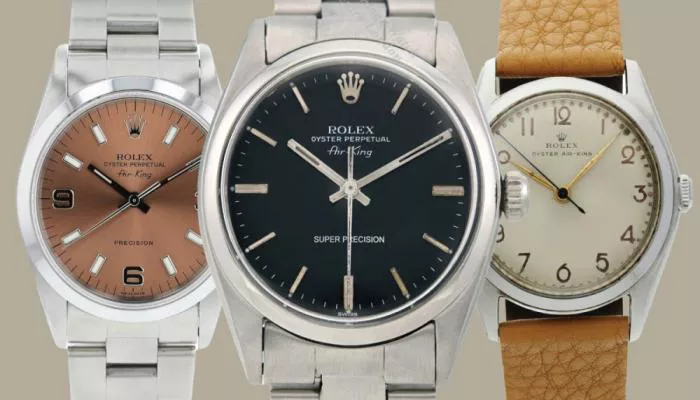For many collectors, Rolex watches represent the pinnacle of horological pursuit. The brand offers a vast array of iconic models, from the avant-garde King Midas to the record-setting Explorer, GMT Master, Daytona, and Submariner. Yet the Air-King stands apart—humbler, often smaller, and mechanically simpler. This understated elegance makes it a perfect fit for today’s “quiet luxury” trend, where even modern Rolex embraces a more restrained aesthetic.
Introduced in 1945 as part of the Air collection—a tribute to World War II pilots and a nod to the emerging jet age—the Air-King was the sole survivor among its siblings (Air-Giant, Air-Lion, and Air-Tiger). Despite a brief hiatus in 2014, the Air-King has remained in continuous production, ensuring a steady supply of vintage, neo-vintage, and pre-owned models for enthusiasts.
A Hybrid of Sport and Dress Watch DNA
Like many mid-20th-century Rolex models, the Air-King blended sport and dress watch elements. Its sports pedigree included a waterproof Oyster case and robust shock resistance, both refined over decades. In 1953, it gained an automatic movement, and in 2007, it achieved chronometer-grade precision. Dress watch traits included a modest case size, plain stainless-steel bezel, simple dial, and time-only functionality—making it a more restrained alternative to the Datejust and Day-Date.
Rolex’s industrial approach to watchmaking means the Air-King shares parts with models like the Oyster Perpetual, Milgauss, and Explorer I. These similarities have persisted over the years, as Rolex maintains its modular production strategy.
Decoding Reference Numbers
Understanding Rolex’s reference numbering system—four-digit, five-digit, and six-digit codes—is crucial for collectors. While most significant changes affected more complex models like the Datejust or Submariner, the Air-King saw shifts in case size, movements, and dial variations. Transitional years, when Rolex phased in new components, often resulted in hybrid watches with mixed parts, adding to the model’s mystique.
Key Models in the Air-King Lineage
Reference 4925 (1945–1953): The Original
The inaugural Air-King featured:
- 34mm stainless steel Oyster case (50m water resistance, screw-down crown, drilled lugs)
- Manual-wind Caliber 10.5 (15 jewels, 18,000vph)
- White eggshell dial with gold Arabic numerals and italicized “Rolex Oyster Air-King” text
Reference 6552 (1953–1957): The Template Setter
This model introduced the automatic Caliber 1030, later used in Explorers and no-date Submariners. Key traits:
- 34mm Oyster case
- Alpha hands and “Super Precision” dial script
- 3-link Oyster bracelet
Reference 5500 (1957–1989): The Longest Runner
Produced for 32 years, the 5500 saw incremental updates:
- Calibers 1520 (non-chronometer) and 1530 (chronometer)
- Dial variations including co-branded editions (e.g., Tiffany & Co., Domino’s Pizza)
Reference 14000 (1989–2006): The Neo-Vintage Shift
Marking the transition to modern features:
- Sapphire crystal and hacking movement
- Expanded dial colors (salmon, blue, 3-6-9 layouts)
Reference 116900 (2016–2022): A Bold Reinvention
A radical departure:
- 40mm case with Milgauss-inspired antimagnetic shielding
- Matte black “dashboard” dial with green seconds hand
Reference 126900 (2022–Present): The Modern Evolution
The current iteration features:
- Updated Caliber 3230 with Chronergy escapement
- Crown guards and Explorer-style luminescent markers
Navigating the Air-King Market
Collectors should beware of transitional models, service replacements, and dial variations. Rolex’s historical use of interchangeable parts means exceptions abound—some watches may combine elements from different eras.
For those entering the world of Air-King collecting, patience and research are key. Whether drawn to the vintage charm of the 4925 or the modern tool-watch appeal of the 126900, the Air-King offers a rich horological journey.


